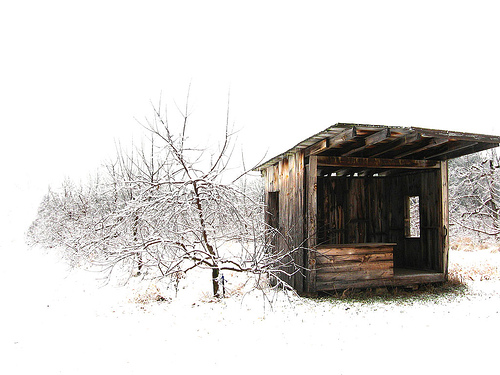
Photo by Eric Myers.
Cross-posted from Gilt Taste.
There’s an old Bob Dylan line: “He not busy being born is busy dying.” It’s one to keep in mind when looking at farms in winter, at the brown fields, skeletal orchards, and vineyards waiting for a shot of green. Despite appearances, winter is a surprisingly important time on a farm. There’s a lot going on, biologically, below the surface, much that can influence what we see on market tables for the rest of the year. And much that can go wrong if the winter is warm, as this one has been in the Northeast.
First, the deep, killing, subfreezing cold of winter typically eliminated many damaging insects and pathogens. As Cornell University Fruit Integrated Pest Management Coordinator Dr. Juliet Carroll explains, “A classic example is Stewart’s Wilt of corn. For Stewart’s Wilt, the bacterium that causes the disease overwinters in the flea beetle that feeds on corn. If winter temperatures are low enough, the risk of Stewart’s Wilt may be completely eliminated for a region.” But if that deep cold doesn’t come, an outbreak of Stewart’s Wilt can mean smaller harvests, higher prices, and frustrated farmers.
Beyond killing the baddies, proper cold serves another important purpose: For perennial crops, shorter days and sustained low temperatures bring a cycle of dormancy, a deep, almost anesthetized sleep, during which growth is temporarily halted. Measured in “chilling hours,” this is the time when plants’ energy is held in reserve, building up for new growth, and farmers can prune and transplant without fear of sprouting. Without sufficient chilling time, a fruit tree will generate fewer, weaker buds, limiting fruit production from day one. Growers monitor chilling hours in a season with a wary eye.
And it’s not just produce that’s affected by warm winter weather. Steve Vilnit, Director of Fisheries Marketing for the Maryland Department of Natural Resources, has seen this season’s haul of yellow perch come in unusually quickly, because “normally the waters where the perch are caught are frozen over for most of January … this year that wasn’t the case.” And while this may lead to more comfortable working conditions and easier money for fishermen, hitting catch limits early can lead to an earlier end for the season, “mess[ing] up the promotion of the fishery, as restaurants can no longer plan ahead to have it on the menu.”
Of course, some growers don’t really mind the warmth. Richie Pisacano, vineyard manager for Wölffer Estate winery in Sagaponack, N.Y., says, “A mild winter like we are having is welcome in the vineyard … with temperatures still mostly dipping into the 30s and low 40s, keeping the vines completely dormant. Pruning is much more pleasant.” Winemaker Roman Roth adds, “It is a wonderful relief not have a tough winter after last year’s snowstorms.”
But a winter that warms up too much for too long, causing plants to “think” it’s spring, could be truly disastrous if temperatures revert and freeze again. In the Wölffer vineyards, Pisacano worries about his vines’ fragility as they come out of dormancy; if a freeze hits then, their trunks could split, causing fatal damage. As Dr. Carroll explains, “A spring freeze event is very bad because plants have begun to grow, or their buds have started to swell and are less cold hardy.” The line between “rough” and “disaster” on those days is razor thin. In apples, the difference between a frost that causes a 10 percent bud loss and one that loses 90 percent can be under 10 degrees’ difference, held for just a half-hour.
On Feb. 1st, temperatures in New York got up to 62 degrees F. In Washington, D.C., 72. Wild swings of the pendulum like these — suddenly balmy winter days or unseasonal April frosts — are not unknown in history, but their increasing frequency is at least partly the product of climate change. Beyond warming, this may be the most troubling aspect of the new weather regime we live under — that chaos is the new normal.
Mother Nature is becoming a deeply mercurial ally. The little boost she may give with a January thaw, she can take back tenfold with an April freeze. The cold that may keep Stewart’s Wilt at bay for another season can also make for harder working conditions for vineyard workers. The one thing you can say for her, though, is that even in winter, as feeble as this year’s, everything under her domain is busy either being born or dying.



